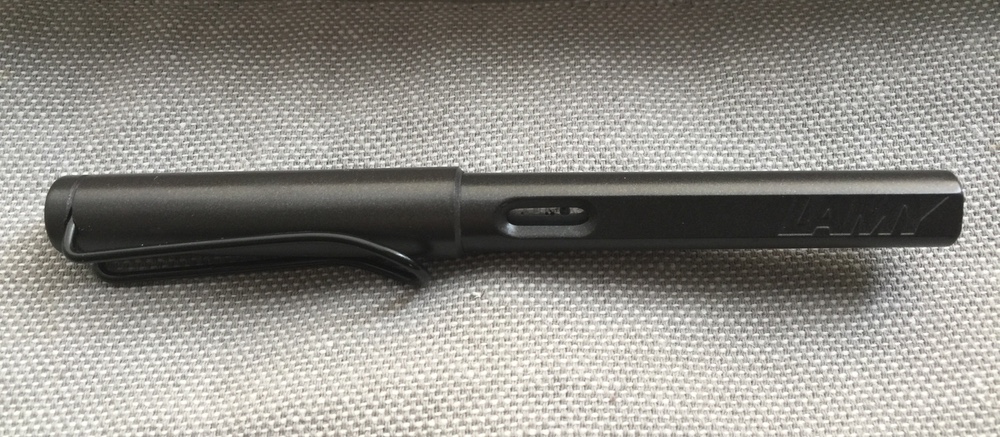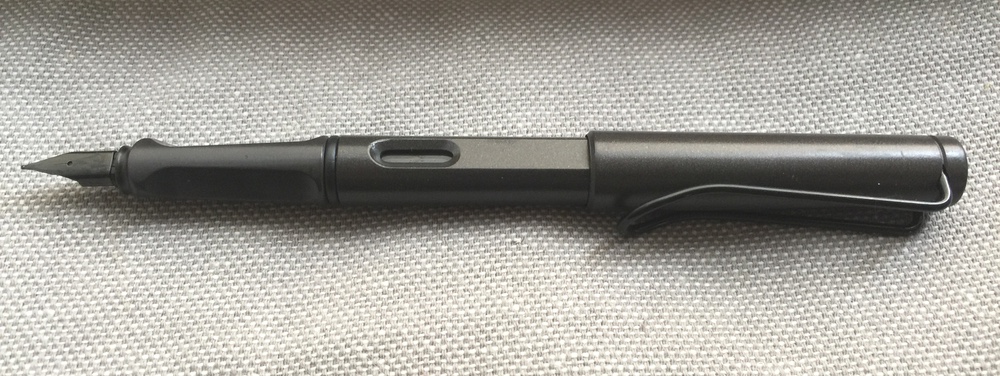I picked up a Lamy Vista while attending a conference in Japan. For those who aren't familiar, the Lamy Vista is basically a sexier demonstrator (see through) version of the Lamy Safari. The Safari is one of the most popular starter fountain pens, along with the Pilot Metropolitan. I'm not sure what I was thinking when I purchased a German pen in a country that produces the Metropolitan; however, I just couldn't turn down this sleek looking demonstrator's cat calls from the pen rack. Lamy pens just look more interesting to me, even if the Pilot Metropolitan is universally considered to be an excellent starter fountain pen. I had a rough start with Lamy, but I just couldn't pass up the Vista.
The Lamy Vista is a stunner, with a clear plastic body that shows off all of the pen's inner workings. Although the body is completely plastic, the pen is made well and feels sturdy in hand. The clip is a monster and is so strong that it leaves indentations when clipped to my daily carry Field Notes notebook. The Vista is built to be used and abused. The pen takes on the personality of the ink inside, so it's a great pen to use with colorful inks. The pen takes the standard Lamy cartridge or an ink converter, but the red on the Lamy Z24 converter would ruin the look of the pen. I recommend the Z26 version which uses black plastic instead of red. Goulet Pens has a great writeup about the usage of converters with the Vista. I'm a fountain pen novice, so I appreciate the ability to see how the pen works, and I'm surprised that the Vista isn't mentioned more often in the "best pens for beginners" lists floating around the internet.
Blue is beautiful with the Lamy Vista
The Vista's body does show fingerprints, which is to be expected from clear plastic. It may not be the best choice for the OCD fountain pen fans out there, but it shouldn't be a problem for most. I've also noticed several scratches and scuffs, which are easily visible to the naked eye. The Lamy barrel logo is shiny and metallic, although I was disappointed by how easily the logo cracked and scratched. Small blemishes aside, the Vista feels great in the hand. I can use the pen comfortably all day, either posted or unposted. The cap clicks into place when capping, but there's no click when posting, so be careful not to jam the cap onto the end of the pen.
Lamy Safari and Vista pens are known for their unique molded triangular grip. This grip may be a challenge for those who use a non-traditional grip when writing, but I absolutely love it! My fingers slide easily into place, thanks to the flat sides of the grip, and I find that this grip makes the pen feel much smaller than it actually is. I love small pens, so this is exactly the feel that I am looking for. My terrible handwriting is partially due to poor grip, and the molded grip forces me to hold the pen correctly. This has been helpful in my efforts to improve handwriting skills.
I was hesitant to give Lamy another go after my terrible experience with the Safari, but I was pleasantly surprised by the Vista. The pen is a workhorse and works well for hours at a time without skips, clogs, or leaks. This pairs well with the grip to help produce painfully long pen reviews with zero fatigue or annoyance to the writer! I purchased a fine nibbed version, which is buttery smooth on everything from Rhodia pads to Field Notes. The Lamy fine nibs aren't exactly "fine", so I recommend picking up the extra fine version, if you're looking for a really slim line. The fine nib works well for me, although I think that I may have been better off with an EF nib.
I have to admit that this is my first pen review, but I'm in love with the Lamy Vista. It was difficult to choose between a Lamy and the Pilot Metropolitan, but the unique look and excellent grip pushed me over the edge. I would love to try a Metropolitan to compare, but there's no doubt that the Lamy Vista is a well-performing affordable pen that's deserving of becoming your first fountain pen.










